engine RENAULT DUSTER 2015 Owners Manual
[x] Cancel search | Manufacturer: RENAULT, Model Year: 2015, Model line: DUSTER, Model: RENAULT DUSTER 2015Pages: 254, PDF Size: 18.85 MB
Page 6 of 254
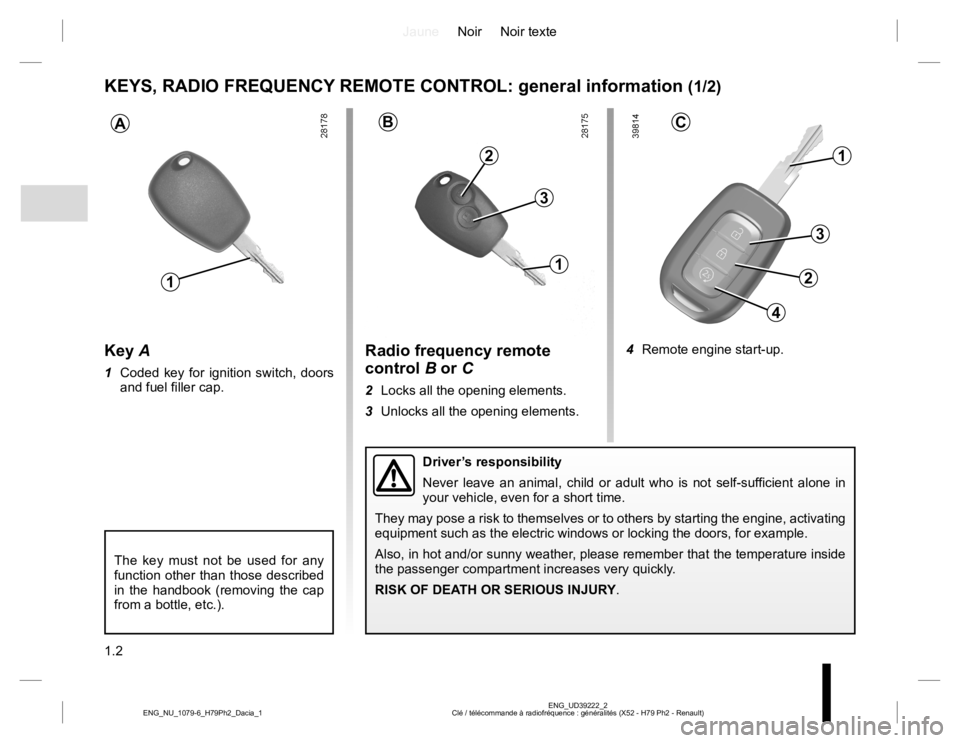
JauneNoir Noir texte
1.2
ENG_UD39222_2
Clé / télécommande à radiofréquence : généralités (X52 - H79 Ph2 - Renault) ENG_NU_1079-6_H79Ph2_Dacia_1
KEYS, RADIO FREQUENCY REMOTE CONTROL: general information (1/2)
Radio frequency remote
control B or C
2 Locks all the opening elements.
3 Unlocks all the opening elements.
Driver’s responsibility
Never leave an animal, child or adult who is not self-sufficient alone in
your vehicle, even for a short time.
They may pose a risk to themselves or to others by starting the engine, activating
equipment such as the electric windows or locking the doors, for example.
Also, in hot and/or sunny weather, please remember that the temperature inside
the passenger compartment increases very quickly.
RISK OF DEATH OR SERIOUS INJURY.
Key A
1 Coded key for ignition switch, doors
and fuel filler cap.
BA
3
2
1
1
The key must not be used for any
function other than those described
in the handbook (removing the cap
from a bottle, etc.).
3
2
4
C
4 Remote engine start-up.
1
Page 8 of 254
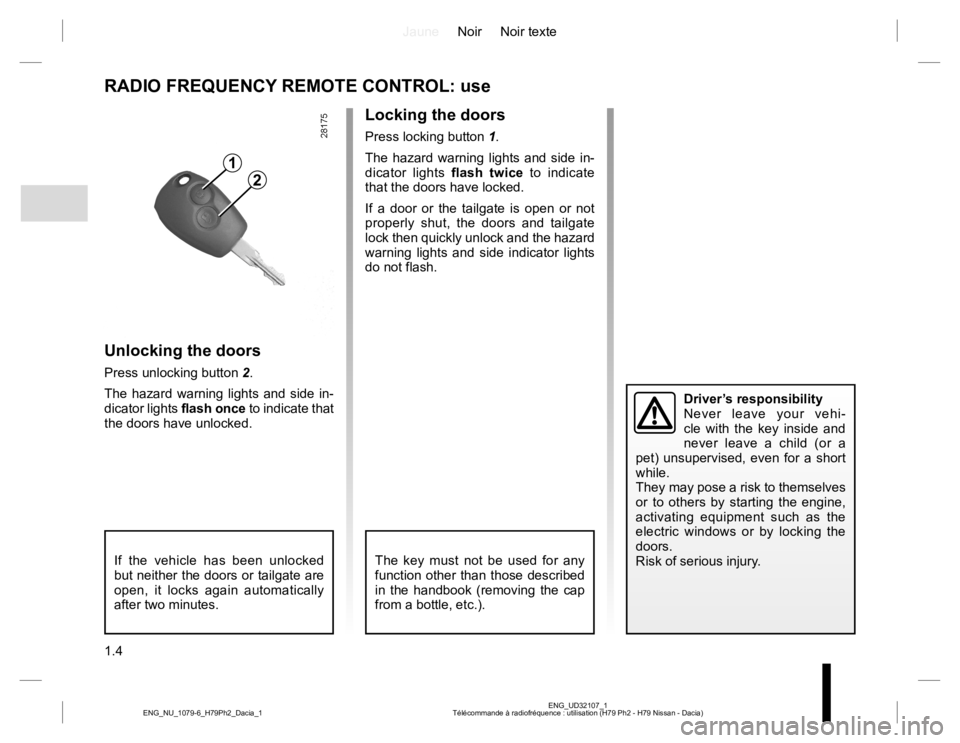
JauneNoir Noir texte
1.4
ENG_UD32107_1
Télécommande à radiofréquence : utilisation (H79 Ph2 - H79 Nissan - Dacia) ENG_NU_1079-6_H79Ph2_Dacia_1
RADIO FREQUENCY REMOTE CONTROL: use
Locking the doors
Press locking button 1.
The hazard warning lights and side in-
dicator lights flash twice to indicate
that the doors have locked.
If a door or the tailgate is open or not
properly shut, the doors and tailgate
lock then quickly unlock and the hazard
warning lights and side indicator lights
do not flash.
Unlocking the doors
Press unlocking button 2.
The hazard warning lights and side in-
dicator lights flash once to indicate that
the doors have unlocked.
1
2
The key must not be used for any
function other than those described
in the handbook (removing the cap
from a bottle, etc.).
Driver’s responsibility
Never leave your vehi-
cle with the key inside and
never leave a child (or a
pet) unsupervised, even for a short
while.
They may pose a risk to themselves
or to others by starting the engine,
activating equipment such as the
electric windows or by locking the
doors.
Risk of serious injury.
If the vehicle has been unlocked
but neither the doors or tailgate are
open, it locks again automatically
after two minutes.
Page 11 of 254
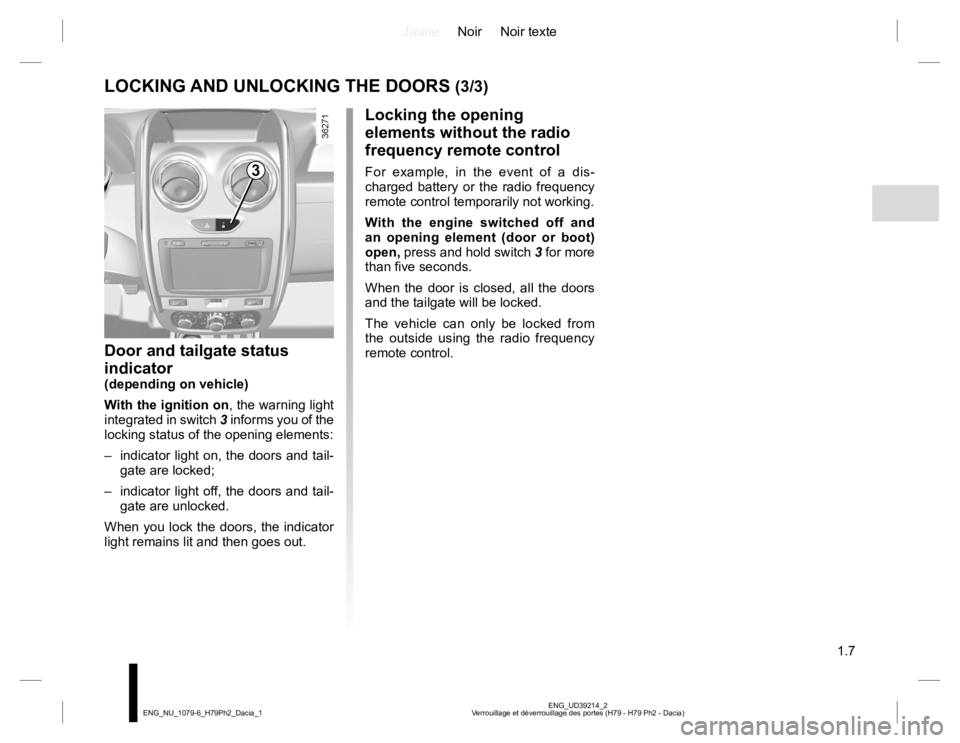
JauneNoir Noir texte
1.7
ENG_UD39214_2
Verrouillage et déverrouillage des portes (H79 - H79 Ph2 - Dacia) ENG_NU_1079-6_H79Ph2_Dacia_1
Door and tailgate status
indicator
(depending on vehicle)
With the ignition on, the warning light
integrated in switch 3 informs you of the
locking status of the opening elements:
– indicator light on, the doors and tail-
gate are locked;
– indicator light off, the doors and tail-
gate are unlocked.
When you lock the doors, the indicator
light remains lit and then goes out.
Locking the opening
elements without the radio
frequency remote control
For example, in the event of a dis-
charged battery or the radio frequency
remote control temporarily not working.
With the engine switched off and
an opening element (door or boot)
open, press and hold switch 3 for more
than five seconds.
When the door is closed, all the doors
and the tailgate will be locked.
The vehicle can only be locked from
the outside using the radio frequency
remote control.3
LOCKING AND UNLOCKING THE DOORS (3/3)
Page 12 of 254
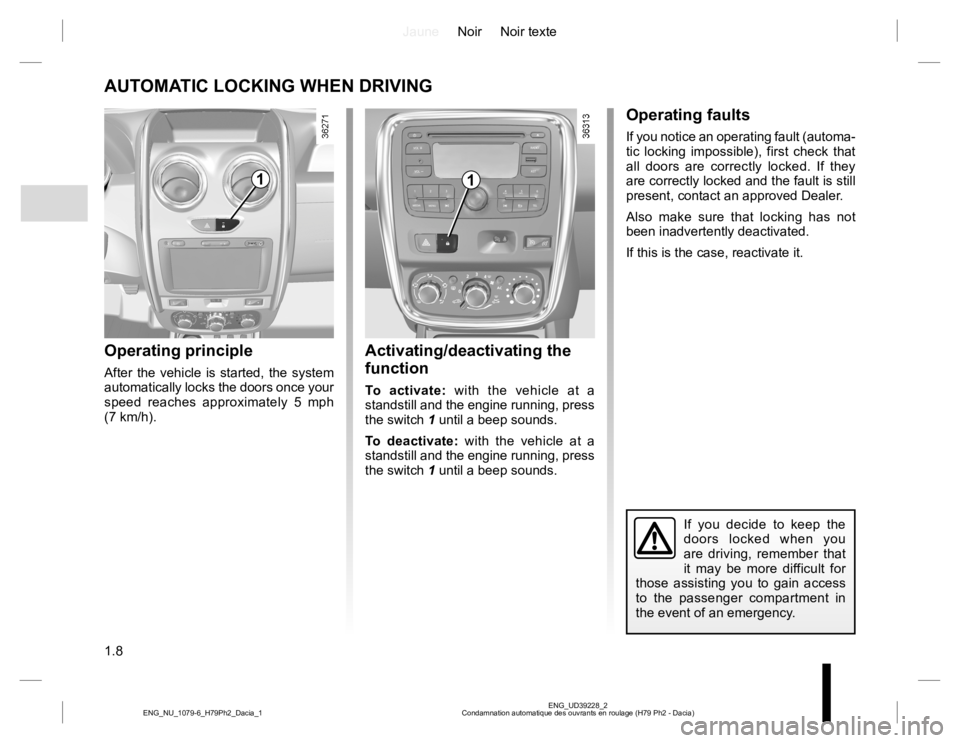
JauneNoir Noir texte
1.8
ENG_UD39228_2
Condamnation automatique des ouvrants en roulage (H79 Ph2 - Dacia) ENG_NU_1079-6_H79Ph2_Dacia_1
AUTOMATIC LOCKING WHEN DRIVING
Operating principle
After the vehicle is started, the system
automatically locks the doors once your
speed reaches approximately 5 mph
(7 km/h).
Activating/deactivating the
function
To activate: with the vehicle at a
standstill and the engine running, press
the switch 1 until a beep sounds.
To deactivate: with the vehicle at a
standstill and the engine running, press
the switch 1 until a beep sounds.
If you decide to keep the
doors locked when you
are driving, remember that
it may be more difficult for
those assisting you to gain access
to the passenger compartment in
the event of an emergency.
Operating faults
If you notice an operating fault (automa-
tic locking impossible), first check that
all doors are correctly locked. If they
are correctly locked and the fault is still
present, contact an approved Dealer.
Also make sure that locking has not
been inadvertently deactivated.
If this is the case, reactivate it.
11
Page 14 of 254
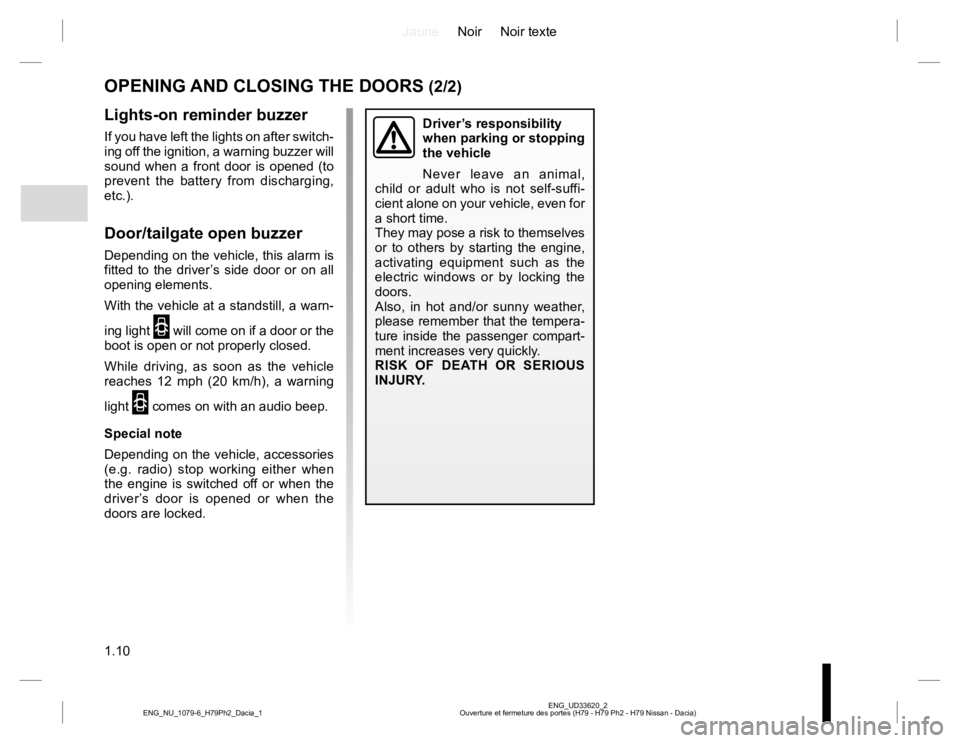
JauneNoir Noir texte
1.10
ENG_UD33620_2
Ouverture et fermeture des portes (H79 - H79 Ph2 - H79 Nissan - Dacia) ENG_NU_1079-6_H79Ph2_Dacia_1
OPENING AND CLOSING THE DOORS (2/2)
Driver’s responsibility
when parking or stopping
the vehicle
Never leave an animal,
child or adult who is not self-suffi-
cient alone on your vehicle, even for
a short time.
They may pose a risk to themselves
or to others by starting the engine,
activating equipment such as the
electric windows or by locking the
doors.
Also, in hot and/or sunny weather,
please remember that the tempera-
ture inside the passenger compart-
ment increases very quickly.
RISK OF DEATH OR SERIOUS
INJURY.Lights-on reminder buzzer
If you have left the lights on after switch-
ing off the ignition, a warning buzzer will
sound when a front door is opened (to
prevent the battery from discharging,
etc.).
Door/tailgate open buzzer
Depending on the vehicle, this alarm is
fitted to the driver’s side door or on all
opening elements.
With the vehicle at a standstill, a warn-
ing light
2 will come on if a door or the
boot is open or not properly closed.
While driving, as soon as the vehicle
reaches 12 mph (20 km/h), a warning
light
2 comes on with an audio beep.
Special note
Depending on the vehicle, accessories
(e.g. radio) stop working either when
the engine is switched off or when the
driver’s door is opened or when the
doors are locked.
Page 19 of 254
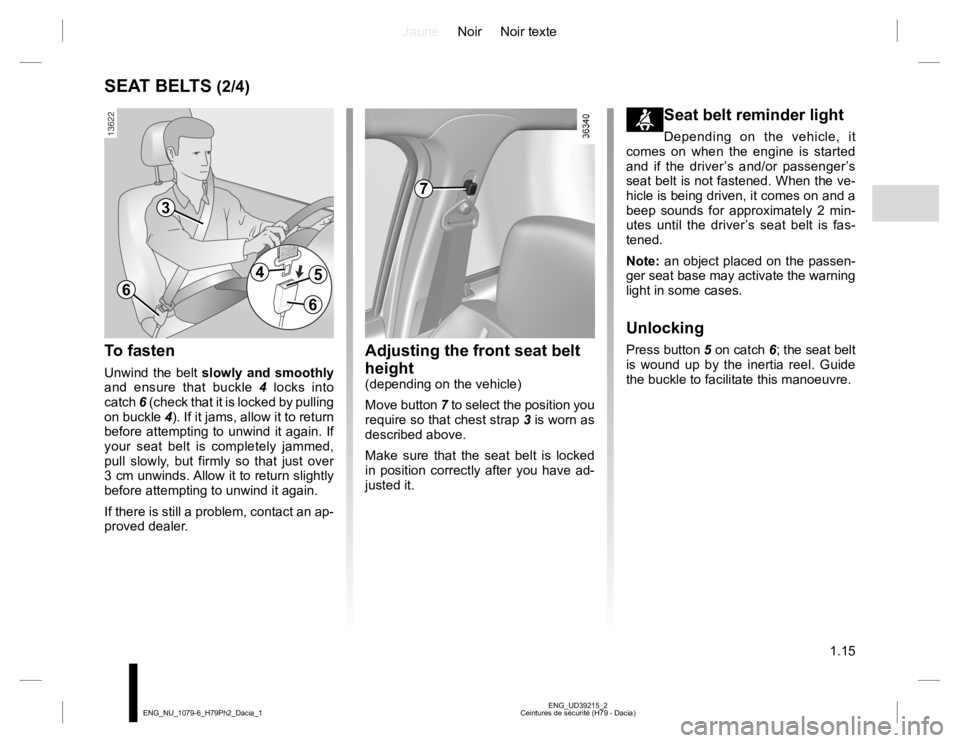
JauneNoir Noir texte
1.15
ENG_UD39215_2
Ceintures de sécurité (H79 - Dacia) ENG_NU_1079-6_H79Ph2_Dacia_1
SEAT BELTS (2/4)
To fasten
Unwind the belt slowly and smoothly
and ensure that buckle 4 locks into
catch 6 (check that it is locked by pulling
on buckle 4). If it jams, allow it to return
before attempting to unwind it again. If
your seat belt is completely jammed,
pull slowly, but firmly so that just over
3 cm unwinds. Allow it to return slightly
before attempting to unwind it again.
If there is still a problem, contact an ap-
proved dealer.
Adjusting the front seat belt
height
(depending on the vehicle)
Move button 7 to select the position you
require so that chest strap 3 is worn as
described above.
Make sure that the seat belt is locked
in position correctly after you have ad-
justed it.
ßSeat belt reminder light
Depending on the vehicle, it
comes on when the engine is started
and if the driver’s and/or passenger’s
seat belt is not fastened. When the ve-
hicle is being driven, it comes on and a
beep sounds for approximately 2 min-
utes until the driver’s seat belt is fas-
tened.
Note: an object placed on the passen-
ger seat base may activate the warning
light in some cases.
Unlocking
Press button 5 on catch 6; the seat belt
is wound up by the inertia reel. Guide
the buckle to facilitate this manoeuvre.
3
45
6
6
7
Page 26 of 254
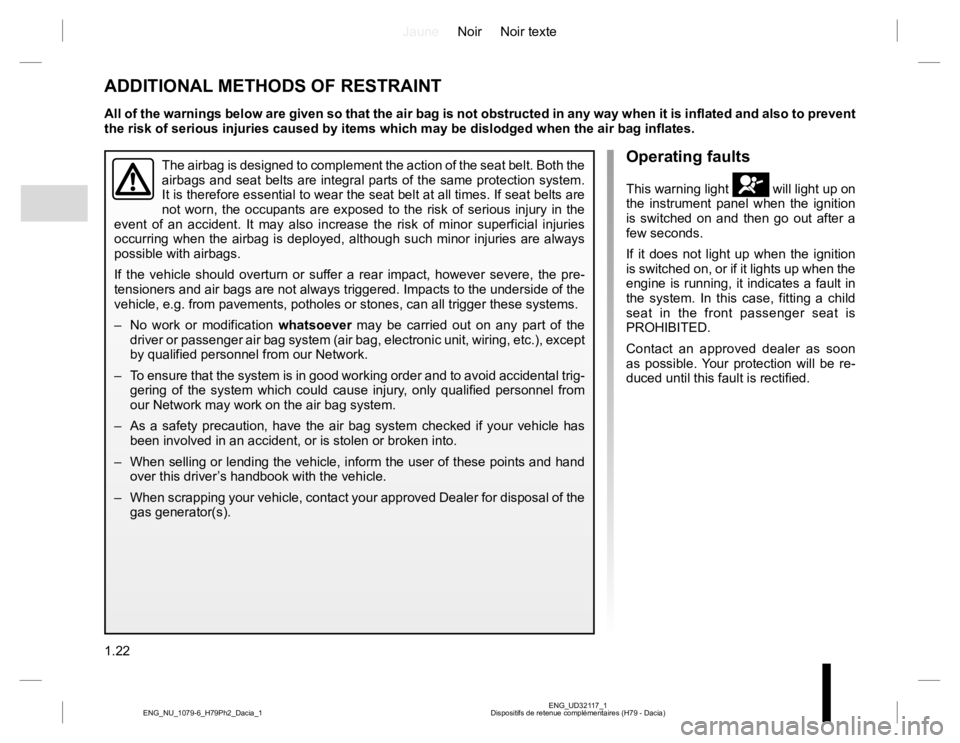
JauneNoir Noir texte
1.22
ENG_UD32117_1
Dispositifs de retenue complémentaires (H79 - Dacia) ENG_NU_1079-6_H79Ph2_Dacia_1
The airbag is designed to complement the action of the seat belt. Both the
airbags and seat belts are integral parts of the same protection system.
It is therefore essential to wear the seat belt at all times. If seat belts are
not worn, the occupants are exposed to the risk of serious injury in the
event of an accident. It may also increase the risk of minor superficial injuries
occurring when the airbag is deployed, although such minor injuries are always
possible with airbags.
If the vehicle should overturn or suffer a rear impact, however severe, the pre-
tensioners and air bags are not always triggered. Impacts to the underside of the
vehicle, e.g. from pavements, potholes or stones, can all trigger these systems.
– No work or modification whatsoever may be carried out on any part of the
driver or passenger air bag system (air bag, electronic unit, wiring, etc.), except
by qualified personnel from our Network.
– To ensure that the system is in good working order and to avoid accidental trig-
gering of the system which could cause injury, only qualified personnel from
our Network may work on the air bag system.
– As a safety precaution, have the air bag system checked if your vehicle has
been involved in an accident, or is stolen or broken into.
– When selling or lending the vehicle, inform the user of these points and hand
over this driver’s handbook with the vehicle.
– When scrapping your vehicle, contact your approved Dealer for disposal of the
gas generator(s).
All of the warnings below are given so that the air bag is not obstructed in any way when it is inflated and also to prevent
the risk of serious injuries caused by items which may be dislodged when the air bag inflates.
ADDITIONAL METHODS OF RESTRAINT
Operating faults
This warning light å will light up on
the instrument panel when the ignition
is switched on and then go out after a
few seconds.
If it does not light up when the ignition
is switched on, or if it lights up when the
engine is running, it indicates a fault in
the system. In this case, fitting a child
seat in the front passenger seat is
PROHIBITED.
Contact an approved dealer as soon
as possible. Your protection will be re-
duced until this fault is rectified.
Page 41 of 254
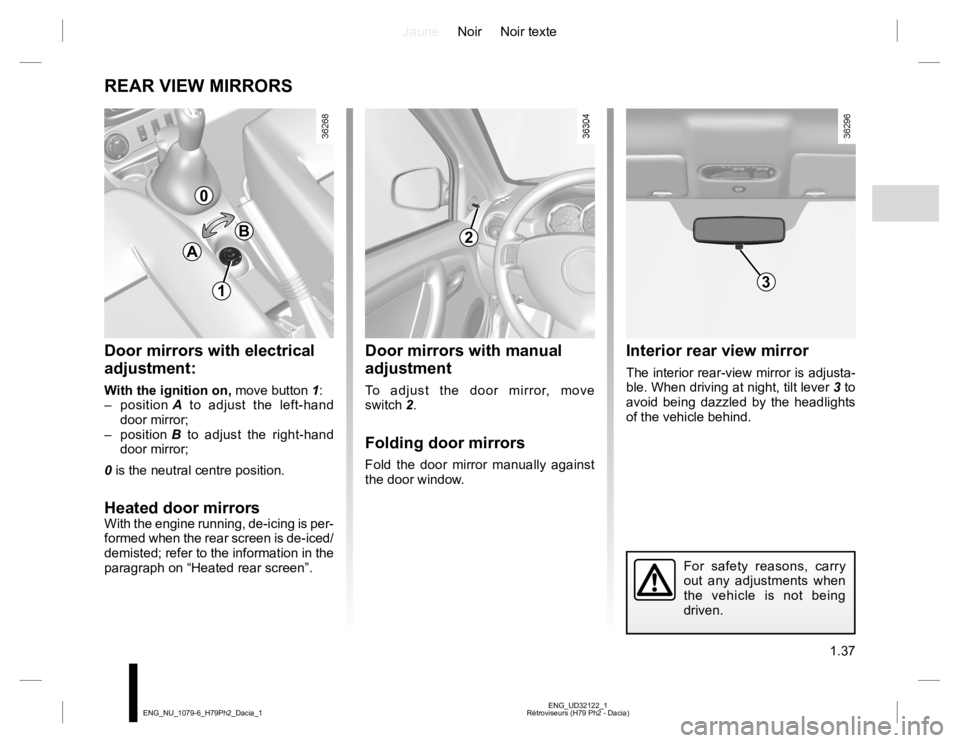
JauneNoir Noir texte
1.37
ENG_UD32122_1
Rétroviseurs (H79 Ph2 - Dacia) ENG_NU_1079-6_H79Ph2_Dacia_1
REAR VIEW MIRRORS
Door mirrors with electrical
adjustment:
With the ignition on, move button 1:
– position A to adjust the left-hand
door mirror;
– position B to adjust the right-hand
door mirror;
0 is the neutral centre position.
Heated door mirrors
With the engine running, de-icing is per-
formed when the rear screen is de-iced/
demisted; refer to the information in the
paragraph on “Heated rear screen”.
Interior rear view mirror
The interior rear-view mirror is adjusta-
ble. When driving at night, tilt lever 3 to
avoid being dazzled by the headlights
of the vehicle behind.
Door mirrors with manual
adjustment
To adjust the door mirror, move
switch 2.
Folding door mirrors
Fold the door mirror manually against
the door window.
For safety reasons, carry
out any adjustments when
the vehicle is not being
driven.
0
B
A
13
2
Page 46 of 254
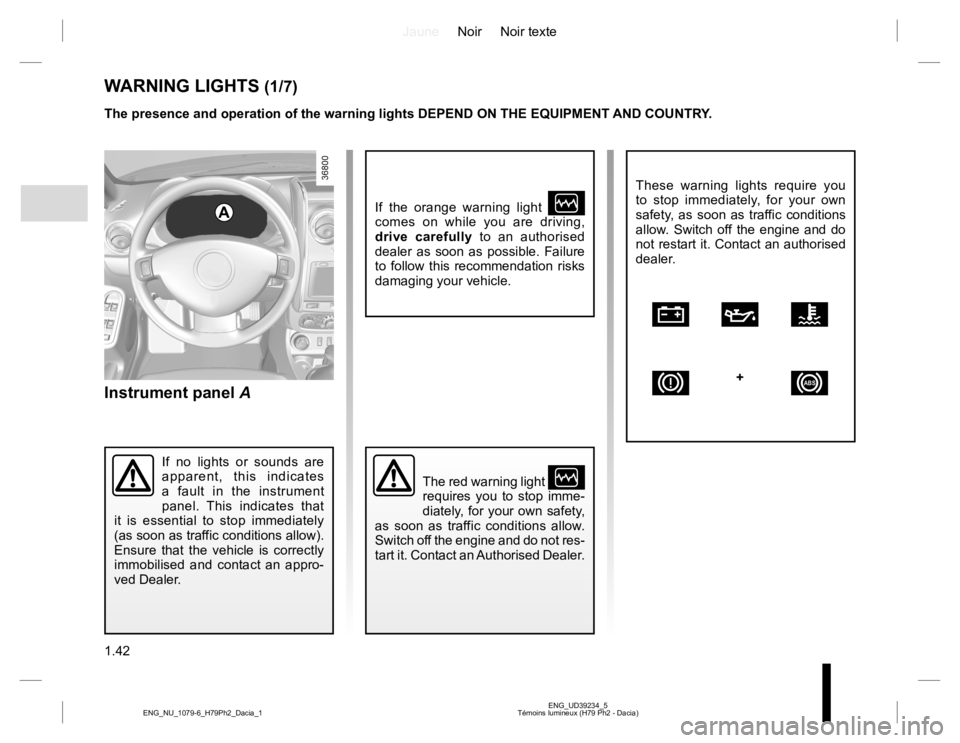
JauneNoir Noir texte
1.42
ENG_UD39234_5
Témoins lumineux (H79 Ph2 - Dacia) ENG_NU_1079-6_H79Ph2_Dacia_1
Instrument panel A
WARNING LIGHTS (1/7)
A
If no lights or sounds are
apparent, this indicates
a fault in the instrument
panel. This indicates that
it is essential to stop immediately
(as soon as traffic conditions allow).
Ensure that the vehicle is correctly
immobilised and contact an appro-
ved Dealer.
If the orange warning light Ò
comes on while you are driving,
drive carefully to an authorised
dealer as soon as possible. Failure
to follow this recommendation risks
damaging your vehicle.
The red warning light Ò
requires you to stop imme-
diately, for your own safety,
as soon as traffic conditions allow.
Switch off the engine and do not res-
tart it. Contact an Authorised Dealer.
The presence and operation of the warning lights DEPEND ON THE EQUIPMENT AND COUNTRY.
These warning lights require you
to stop immediately, for your own
safety, as soon as traffic conditions
allow. Switch off the engine and do
not restart it. Contact an authorised
dealer.
ÚÀÔ
D
+x
Page 47 of 254
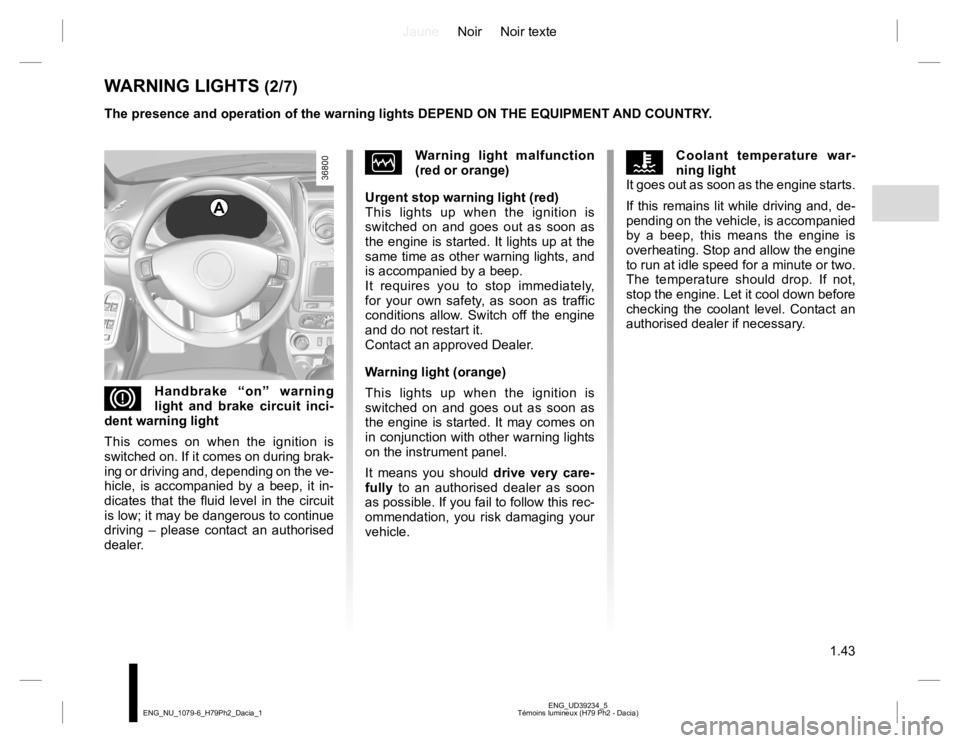
JauneNoir Noir texte
1.43
ENG_UD39234_5
Témoins lumineux (H79 Ph2 - Dacia) ENG_NU_1079-6_H79Ph2_Dacia_1
WARNING LIGHTS (2/7)
A
DHandbrake “on” warning
light and brake circuit inci-
dent warning light
This comes on when the ignition is
switched on. If it comes on during brak-
ing or driving and, depending on the ve-
hicle, is accompanied by a beep, it in-
dicates that the fluid level in the circuit
is low; it may be dangerous to continue
driving – please contact an authorised
dealer.
ÒWarning light malfunction
(red or orange)
Urgent stop warning light (red)
This lights up when the ignition is
switched on and goes out as soon as
the engine is started. It lights up at the
same time as other warning lights, and
is accompanied by a beep.
It requires you to stop immediately,
for your own safety, as soon as traffic
conditions allow. Switch off the engine
and do not restart it.
Contact an approved Dealer.
Warning light (orange)
This lights up when the ignition is
switched on and goes out as soon as
the engine is started. It may comes on
in conjunction with other warning lights
on the instrument panel.
It means you should drive very care-
fully to an authorised dealer as soon
as possible. If you fail to follow this rec-
ommendation, you risk damaging your
vehicle.ÔCoolant temperature war-
ning light
It goes out as soon as the engine starts.
If this remains lit while driving and, de-
pending on the vehicle, is accompanied
by a beep, this means the engine is
overheating. Stop and allow the engine
to run at idle speed for a minute or two.
The temperature should drop. If not,
stop the engine. Let it cool down before
checking the coolant level. Contact an
authorised dealer if necessary. The presence and operation of the warning lights DEPEND ON THE EQUIPMENT AND COUNTRY.